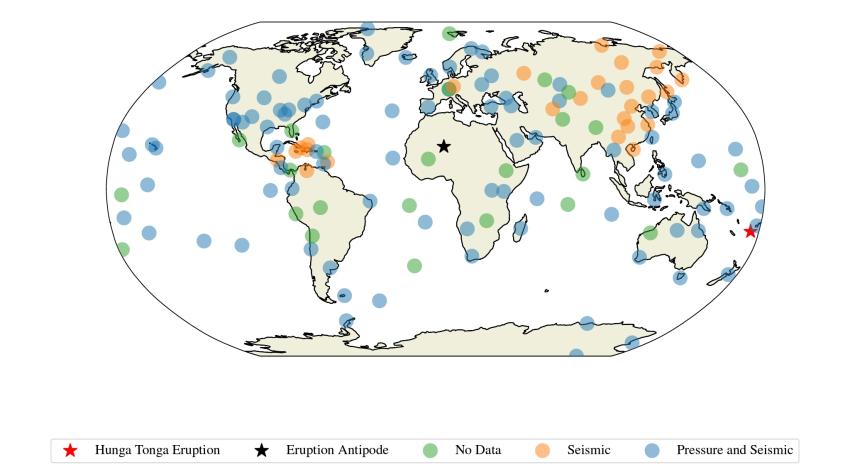A paper accepted for the special issue of Geophysical Journal International (GJI) on the 2022 January 15 eruption of the Hunga Tonga-Hunga Ha’apai volcano examines the connection between the atmosphere and the solid Earth highlighted by this event.
First author, Adam Ringler of the US Geological Survey, said: “Our study looked at how the atmospheric oscillations excited by the Hunga Tonga volcanic eruption coupled into the solid Earth to create seismic oscillations. These signals have a period of approximately 4.5 minutes and can be observed globally on well instrumented seismic stations such as those in the Global Seismographic Network (GSN). These signals could provide key insights into the rupture process as well as a tool to better understand the feedback process between the atmosphere and solid Earth after large eruptions.”
The 2022 January 15 event was recorded worldwide by the seismometers, microbarographs and infrared sensors of the GSN (see the map that accompanies this article). The authors infer that the excitation of fundamental atmospheric modes occurs within a limited area close to the site of the eruption: specifically, microbarographs within 1500 km of the eruption recorded pressure oscillations. They add that pressure data recorded within 1000 km of the eruption displays pronounced spectral peaks near 3.7 mHz; that at the closest microbarograph to the eruption (approx 68 km), pressure oscillation at 3.7 mHz exceeded 200 Pa; and that at Monasavu, Fiji, co-located seismic and pressure observations indicate that initial pressure and ground acceleration oscillations occur in phase.
The authors comment that both the 2022 Hunga Tonga eruption and the 1991 Pinatubo eruption strongly excited the Earth normal mode of 3.72 mHz and that the modal amplitude was roughly 11 times larger for the 2022 Hunga Tonga eruption: they add that the physical reason for this observation is unclear but that it could be due to differences in source processes changing how the atmosphere was excited or differences in the regional atmospheric structure. Unlike the 1991 Pinatubo eruption, most individual seismic stations in 2022 do not display spectral peaks in ground motion near 4.4 mHz.
They further note that extending existing models from one (radial) dimension to three dimensions may partially resolve issues arising from observations following the 2022 Hunga Tonga eruption that are not consistent with previous models.
Duncan Agnew, Deputy Editor-in-Chief of GJI, comments that "This is the first time geophysicists have observed a large volcanic eruption with a global digital seismic net. The analysis in this paper supports earlier observations but gives much more detail that helps to show how the air-pressure wave from the eruption interacts with the solid Earth--though some mysteries remain."
All papers in our special issue are free to read. Read this paper at https://academic.oup.com/gji/advance-article/doi/10.1093/gji/ggac284/6650357



